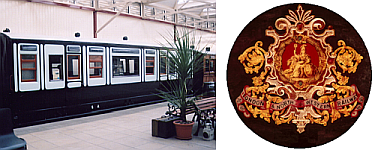


30' 1" Carriages, an overviewIn 1886 Mr.C.A.Park was appointed the new Carriage Superintendent at the LNWR's Wolverton Works. He established new design standards which would be used for almost all new carriages for the next twenty years and several thousand vehicles were built.
42ft, 45ft, 50ft, 28ft and 30ft 1in carriages were constructed, all of the same profile, the same standard compartment sizes and with the same standard features.
With a few exceptions, most 30ft 1in stock was primarily intended for branchlines and this was the first time the LNWR had built vehicles for those services. Previously older mainline carriages had been downgraded to secondary routes and then to branchlines. Compared with the 32ft carriages which they replaced, the new designs were higher at the cantrail, with curved headstock ends and 8ft wide, 7ft 8in high to the top of the roof and 9ft wide over the Guard's lookouts, where fitted
No less than 1,598 carriages were built at Wolverton between 1887 and 1894 on the standard 30ft 1in underframe. Body styles included Third, Brake-Thirds, Luggage-Composites, Lavatory-Composites, Full Brakes, Parcels Vans, Picnic Saloons, Inspection Saloons, Gas-tank Wagons, a Horsebox for Queen Victoria's horses, and others. Most 30ft 1in carriages lasted into the late 1930s, with many continuing into the 1940s and a few even beyond. In departmental use several lasted into the 1960s.
The underframe was a composite design with central longitudinal members made of Oak, but steel solebars, headstocks and bracing. The body framing was Oak, with 3/8in thick Mahogany panelling secured by 3/8in Mahogany beading pinned on and Mahogany bolection mouldings around the windows. The roof was pine boards, planed to a smooth curve and covered with white lead and canvas.
Fourteen Picnic Saloons were built in 1890 - 1892 To D84. They had a central saloon with bench seats and fixed tables. At one end was a lavatory compartment and at the other a luggage compartment. It appears that ventilation proved to be a problem because in the main saloon seating 18 people, only the droplights in the four doors could be opened as the four longlights in the sides were fixed. A further fifteen Picnic Saloons were then built to D85 in 1894. These were outwardly identical except that there was just one longlight each side and a new opening window either side, giving a total of eight opening windows in the saloon.
If a small group of people wished to travel together they might book a compartment, but a larger group could book a whole carriage, and a Picnic Saloon would be ideal for them. They were "dual fitted" for both vacuum and Westinghouse brakes, so could travel all over the country.